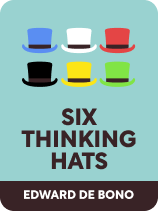

This article is an excerpt from the Shortform book guide to "Six Thinking Hats" by Edward de Bono. Shortform has the world's best summaries and analyses of books you should be reading.
Like this article? Sign up for a free trial here .
What is Edward de Bono’s 6 hats theory? What are the six types of thinking represented by the six hats?
Psychologist Edward de Bono published Six Thinking Hats in 1985, but his concepts still hold up today. He uses his 6 hats theory to represent the six different types of thinking: metacognitive, data-focused, emotional, critical, constructive, and creative.
Keep reading to learn about de Bono’s 6 hats thinking theory.
Edward de Bono: The 6 Hats Theory
Six Thinking Hats is a handbook for training people to think more efficiently and productively, using the metaphor of wearing different types of hats for different types of thinking. Since the book’s original publication, many institutions have implemented it with great success, particularly in business and educational contexts. Author Edward de Bono is a Maltese doctor and psychologist. He’s credited with coining the term “lateral thinking,” and he’s also known for advocating more teaching of thinking skills in schools.
Six Thinking Hats was originally published in 1985. This guide refers to the revised and updated version published in 2017.
Meet the Six Hats
De Bono’s six hats represent the following types of thinking:
- The blue hat is for metacognition, or the overall organization of the thinking process.
- The white hat is for gathering neutral information.
- The red hat is for emotions.
- The black hat is for criticism.
- The yellow hat is for positive feedback and developing solutions.
- The green hat is for new, creative ideas.
When you face an important decision, the hats can help you compartmentalize and organize your thinking. In group discussions, the hats help to keep things clear and orderly, as well as making sure that no important ideas are neglected.
Why We Need to Develop Specific Thinking Skills
The six types of thinking presented through the 6 hats theory aren’t radically new or different from the thinking you already do, but the hats system is more efficient. When presented with a problem, you already think about the information you have, your feelings about the problem, drawbacks and risks, potential novel solutions, and so on. But you probably do this in a fairly haphazard way.
The six thinking hats allow you to pull apart the tangle of normal thinking and sort it into six self-contained strands. Because you keep the strands separate right from the beginning, you can weave them together in a much more deliberate and systematic way. This improves the efficiency of the thinking process. It also transforms thinking into a collaborative effort rather than an argument, which results in more harmonious meetings, more consensus, and better-considered outcomes.
Today’s schools are good at teaching content. But most fail at something more basic: teaching children how to think. Most children learn thinking skills indirectly, via examples that prioritize debate and argumentation.
Our Western intellectual tradition is essentially dialogic in nature. It dates back to the ancient Greeks (Socrates, Plato, and Aristotle) who codified a thinking style based on debate, questioning, and intellectual combat. Under this tradition, each person presents their ideas as completely as possible, and then another person clarifies and refines them through criticism and argument. We usually experience this dynamic in a confrontational way: If you have an idea, you present it as completely as possible. Then you defend it while other people attack it from different angles. You can think of this as the “marble statue” approach: Start with a complete block of marble and chip away at it until you have what you need.
Because our culture has been steeped in this tradition for thousands of years, it’s invisible. To us it just feels like normal thinking. But what happens when we use a different metaphor to think about thinking? What if the statue is made out of clay or sand rather than marble—so instead of carving off what you don’t need, you’re starting with nothing and gradually building? Or what if thinking is a journey that you go on with friends?
Thinking as Exploration
The 6 hats theory asks you to drop the idea that thinking is combat. Instead, see it as mental exploration in a particular direction. In the physical world, you can always check a compass and then choose to walk to the north, south, east, or west. The six hats work in the same way. Think of them as mental compass points. At any point, you can stop and consciously decide on the best course. With each step you take, you’re charting the terrain of the decision you’re currently facing.
Trying to walk north and south at the same time would be pointless and exhausting for your physical body. Similarly, trying to engage in two or more types of thinking at once is inefficient and exhausting for your mind. Your brain works best when it can focus on one type of thinking at a time. If it’s looking for danger, let it look for danger uninterrupted. If it’s creatively breaking existing patterns to make new ones, let it do that. Our normal, untrained thinking is usually a poorly controlled jumble of different types of thinking, and we often rely on pure luck to stumble with solutions.
Think of a drunk person stumbling around an area randomly looking for gold. Now think of an explorer with a compass, systematically walking through the area and sketching out a map as she goes. Who’s more likely to find the gold?
Conducting a systematic mental exploration of the problem allows you to draw a detailed map of the context for any decision you need to make. With this detailed map in hand, your decisions will be so thoroughly considered that the best route will become obvious.
Why Hats?
One of the reasons that de Bono selected hats as metaphors for this new thinking method was the pre-existing association between thinking and hats. He simply took the phrase “put your thinking cap on” and diversified it. But the hat metaphor is helpful for other reasons. For example, a hat is something that’s easy to put on and take off. This mirrors the six different thinking styles, which you can ideally call upon in a flexible and relatively effortless manner.
Hats are also visually obvious. If someone else is wearing a hat, you’ll notice. This signposting function is important in the Six Hats method because you want your current thinking direction to be clear to everyone, including to yourself. By putting on your metaphorical hat, you’re signposting the direction that your thoughts will take.
Another basic feature of hats is that they’re temporary. You put hats on and then take them off, and who you are doesn’t change fundamentally in the process. In the Six Hats system, there are no thinking specialists, no “yellow hat people” or “black hat people.” (The only exception is the blue hat role, which is usually executed by one person at a time—more on this in Chapter 2.) You may have a natural tendency toward one or more of the hats, and that’s fine. But changing hats constantly keeps you from getting stuck. The temporary nature of the hats can be liberating for those who always find themselves cast in the same role in meetings, perhaps as “the creative one” or “the wet blanket.”
On an individual level, the method builds cognitive flexibility. Instead of taking pride in their ability to critique an idea, or in their ability to find and synthesize relevant information, people instead learn to be proud of their versatility. Consider an actor who always dresses up in the same costume and plays the same role. Now consider an actor who can don wildly different costumes and excel in a variety of roles. Which actor do you admire more?
Using the Hats Effectively in a Group
In a meeting or group discussion, a good strategy is to ask everyone to put on each hat for a given time period. The facilitator can do this through statements such as the following:
- “Put on your white hats and give me everything you know about whether our current koala conservation strategy is working.”
- “I want to know how each of you feels about this potential strategy. Put on your red hats and let’s go around the table. I want a few words from each of you that describe your emotional reaction to what we’re proposing.”
- “We’ve generated quite a few new ideas here. Let’s put on our black hats and see what problems we can find with each.”
Individuals can also invoke the hats in free discussion. For example:
- “Putting on my black hat for a second, I see a few reasons why this proposal isn’t likely to work.”
- “Speaking with my red hat on, I really have a good feeling about this supplier. I trust them, and I want to do business with them.”

———End of Preview———
Like what you just read? Read the rest of the world's best book summary and analysis of Edward de Bono's "Six Thinking Hats" at Shortform .
Here's what you'll find in our full Six Thinking Hats summary :
- A handbook for training people to think more efficiently and productively
- An explanation of each of the six thinking hats created by Edward de Bono
- How to calm your inner critic and dramatically cut your decision-making time






